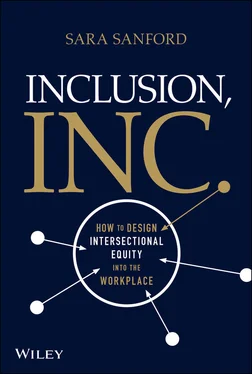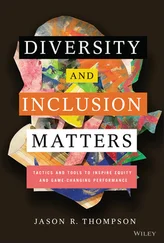138 137
139 138
140 139
141 140
142 141
143 142
144 143
145 144
146 145
147 146
148 147
149 148
150 149
151 150
152 151
153 152
154 153
155 154
156 155
157 157
158 158
159 159
160 160
161 161
162 162
163 163
164 164
165 165
166 166
167 167
168 168
169 169
170 170
171 171
172 172
173 173
174 174
175 175
176 176
177 177
178 179
179 180
180 181
181 182
182 183
183 184
184 185
185 186
186 187
187 188
188 189
189 190
190 191
191 193
192 194
193 195
194 196
195 197
196 198
197 199
198 200
199 201
200 203
201 204
202 205
203 206
204 207
205 209
206 210
207 211
208 212
209 213
210 235
211 236
212 237
213 239
214 240
215 241
216 242
217 243
218 244
219 245
220 246
221 247
SARA SANFORD
HOW TO DESIGN INTERSECTIONAL EQUITY INTO THE WORKPLACE

Copyright © 2022 by Sara Sanford. All rights reserved.
Published by John Wiley & Sons, Inc., Hoboken, New Jersey.
Published simultaneously in Canada.
No part of this publication may be reproduced, stored in a retrieval system, or transmitted in any form or by any means, electronic, mechanical, photocopying, recording, scanning, or otherwise, except as permitted under Section 107 or 108 of the 1976 United States Copyright Act, without either the prior written permission of the Publisher, or authorization through payment of the appropriate per-copy fee to the Copyright Clearance Center, Inc., 222 Rosewood Drive, Danvers, MA 01923, (978) 750-8400, fax (978) 646-8600, or on the Web at www.copyright.com. Requests to the Publisher for permission should be addressed to the Permissions Department, John Wiley & Sons, Inc., 111 River Street, Hoboken, NJ 07030, (201) 748-6011, fax (201) 748-6008, or online at http://www.wiley.com/go/permissions.
Limit of Liability/Disclaimer of Warranty: While the publisher and authors have used their best efforts in preparing this work, they make no representations or warranties with respect to the accuracy or completeness of the contents of this work and specifically disclaim all warranties, including without limitation any implied warranties of merchantability or fitness for a particular purpose. No warranty may be created or extended by sales representatives, written sales materials or promotional statements for this work. The fact that an organization, website, or product is referred to in this work as a citation and/or potential source of further information does not mean that the publisher and authors endorse the information or services the organization, website, or product may provide or recommendations it may make. This work is sold with the understanding that the publisher is not engaged in rendering professional services. The advice and strategies contained herein may not be suitable for your situation. You should consult with a specialist where appropriate. Further, readers should be aware that websites listed in this work may have changed or disappeared between when this work was written and when it is read. Neither the publisher nor authors shall be liable for any loss of profit or any other commercial damages, including but not limited to special, incidental, consequential, or other damages.
For general information on our other products and services or for technical support, please contact our Customer Care Department within the United States at (800) 762-2974, outside the United States at (317) 572-3993 or fax (317) 572-4002.
Wiley also publishes its books in a variety of electronic formats. Some content that appears in print may not be available in electronic formats. For more information about Wiley products, visit our web site at www.wiley.com.
Library of Congress Cataloging-in-Publication Data
Names: Sanford, Sara, author.
Title: Inclusion, inc : how to design intersectional equity into the workplace / Sara Sanford.
Description: Hoboken, New Jersey : Wiley, [2022] | Includes bibliographical references and index.
Identifiers: LCCN 2021062103 (print) | LCCN 2021062104 (ebook) | ISBN 9781119849766 (cloth) | ISBN 9781119850038 (adobe pdf) | ISBN 9781119850021 (epub)
Subjects: LCSH: Intersectionality (Sociology) | Work environment.
Classification: LCC HM488.5 .S26 2022 (print) | LCC HM488.5 (ebook) | DDC 305.3—dc23/eng/20220119
LC record available at https://lccn.loc.gov/2021062103LC ebook record available at https://lccn.loc.gov/2021062104
Cover Image: Wiley
Cover Design: Wiley
For my parents, for always believing.
And for anyone who's ever been underestimated.
Readers will come to this book with varying levels of diversity, equity, and inclusion (DEI) vocabulary. The dialogue around DEI is continuously evolving, and words can have different meanings for different people. This brief guide provides a common language framework for the rest of the book. It is not intended as a glossary, but rather to clarify how DEI language is being used in Inclusion, Inc .
Why is “Black” capitalized in this book, but not “white,” when referring to race?
In July 2020, the New York Times announced that, after a month of discussion, they would capitalize Black when describing people and cultures of African descent. 1 Hundreds of news organizations, including the Associated Press, made the same choice in the spring and summer of 2020. Most news organizations have declined to capitalize “white” because it is an identifier of skin color, rather than of shared experience.
For the reasons stated by these organizations, I have chosen to capitalize “Black” and not “white” when referring to race in Inclusion, Inc .
The term “DEI” stands for diversity, equity, and inclusion. In this book, it is used to refer to the field of work that focuses on ensuring that employees of all backgrounds—especially underestimated backgrounds—are included, treated fairly, and given the same opportunities to advance as their peers.
Diversity . The presence of individuals who differ from one another in a range of ways, such as socioeconomic status, age, gender identity, ethnicity, race, language, and religion.
Equity . Fairness of treatment for employees of all backgrounds. The distinction between equity and equality is important: Equity does not mean equal treatment, but rather creating equal access to opportunities through equitable practices.
Inclusion . Moving beyond recruiting underestimated individuals to involving them in decision-making and valuing and rewarding their contributions. One of my favorite definitions of inclusion came from DEI expert Verna Myers: “Diversity is being asked to the party. Inclusion is being asked to dance.”
How class, race, age, gender, sexual orientation, and other aspects of identity “intersect” with one another or overlap. For example, the experiences of being Latinx or being a woman are not the same as being Latinx and a woman. Certain biases are only experienced when living at the intersection of these two identities.
Читать дальше













